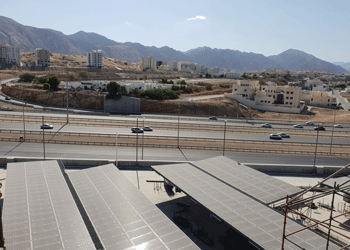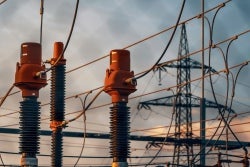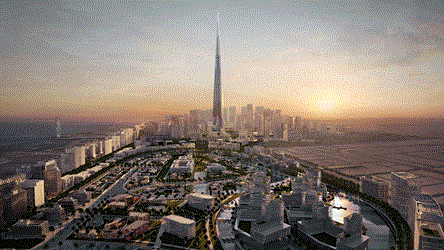Chinese firms dominate region’s projects market
5 March 2025

This package also includes: China construction at pivotal juncture
Chinese construction companies secured over $90bn in contracts in the Middle East and North Africa (Mena) in 2024. Their market share was 26% of the $347bn total for the region, according to regional projects tracker MEED Projects.
The record-breaking performance underscores the growing influence of Chinese firms in the region’s projects market.
In the past decade, Chinese construction companies have steadily increased their foothold in the region.
Between 2015 and 2019, the value of contracts won by Chinese firms ranged from $12bn to $23bn, reflecting a solid presence. There was a dip in 2016, when $12bn of awards reflected government spending cuts, and a second occurred in 2020, when lower oil prices and the impact of the Covid-19 pandemic led to awards of $13bn.
Since the pandemic, Chinese contractors’ orderbooks have grown sharply, with contract values rebounding to $26bn in 2021, dipping slightly in 2022 to $22bn. Then, in 2023, contracts awarded to Chinese contractors more than doubled to $51bn, rising even further to reach a record-breaking $90bn in 2024.
Leading players
According to MEED Projects, the top-ranking company by contract value and project volume based on work at the execution stage is China State Construction Engineering Corporation (CSCEC), with 47 projects totalling $23.5bn.
The other active companies are Sepco 3 Electric Power Construction Corporation, with $17.1bn of work across 14 projects; PowerChina, with $17bn across 22 projects; and Hualu Engineering & Technology, with $14bn of work concentrated in just three high-value projects.
Sinopec and China Energy Engineering Corporation managed 19 and 14 projects, respectively, reflecting their broad engagement in the region.
China Harbour Engineering Company has a more diversified orderbook, with 32 projects worth a total of $8.1bn. Meanwhile, China Petroleum Engineering & Construction Corporation has 27 projects, amounting to $5.7bn.
China’s strengths
The record volumes of work secured by Chinese contractors in recent years can be explained by a combination of factors.
Saudi Arabia has become the largest market for Chinese contractors in the Mena region
Traditionally, Chinese firms have enjoyed a lower cost base than their international competitors. This comes from lower manpower costs, access to cheaper materials and equipment, and financial support from state banks.
Culturally, Chinese firms have typically had a different attitude to risk than many other contractors. Instead of seeking to turn a profit on specific projects, Chinese firms have entered markets cautiously and, as their knowledge of the local market grew, built a commanding long-term position.
More recently, the edge that Chinese contractors enjoy has come from the technical experience they have gained from delivering large-scale, complex projects in their domestic market. While in the past Chinese contractors were only considered capable of delivering basic construction work, they now have some of the best project references in the world.
This was demonstrated in 2024, when CSCEC competed to complete the 1,000-metre-plus tower in Jeddah. The work was eventually given back to the incumbent Saudi Binladin Group, but when CSCEC was pursuing the contract, it boasted a portfolio of several completed super-high-rise and mega-tall projects, exceeding anything its competitors could demonstrate.
Meanwhile, in the UAE, the five groups that competed for the $5.5bn contract for Dubai Metro’s Blue Line extension all had at least one Chinese firm as a consortium member. The eventual winner was a team of Turkiye’s Limak Holding and Mapa Group with the Hong Kong office of China Railway Rolling Stock Corporation.
Oil and gas is another area where expertise has been developed. Twenty years ago, Chinese contractors could not prequalify for work on most oil and gas projects in the region, but today they compete for and win work from Mena’s leading oil companies. For example, Chinese firms won four of the 17 contracts awarded last year for the third expansion phase of Saudi Aramco’s Master Gas System project.
China’s domestic market has created a pool of resources that are being deployed internationally as the outlook for the Chinese construction market shows signs of weakness.
Chinese contractors have also been able to give their clients the solutions they require.
In North Africa, they have raised finances for projects in countries that in some cases lack funding. This has enabled Chinese companies to develop a steady pipeline of projects across North Africa.
In February this year, China’s Tianchen Engineering Corporation was selected by state-owned Egyptian Petrochemicals Holding Company to execute three contracts to develop industrial projects in Egypt. In Algeria, the Agence Nationale d’Etudes et de la Realisation des Investissements Ferroviaires (Anesrif) awarded a $476m railway line upgrade contract in late 2024 to a joint venture of China Railway Sixth Group and the local Infrarer.
In Saudi Arabia, where funding is less of a concern, Chinese contractors have been able to deploy the large project teams required to deliver Riyadh’s Vision 2030.
 Saudi foothold
Saudi foothold
Saudi Arabia has become the largest market for Chinese contractors in the Mena region, with $43bn of contract awards in 2024. This accounted for nearly 30% of the $143bn total for the kingdom last year.
Saudi Arabia’s Vision 2030 comes at a perfect time for Chinese contractors. Riyadh is hungry for resources to deliver its ever-growing roster of projects, including the five official gigaprojects, the requirements of which are extensive.
At the top level, they require funding and financial support, but contractors and suppliers are also needed to deliver the projects. The contract award numbers show that Chinese companies looking to expand their international reach have latched onto this opportunity.
For China, Saudi Arabia is not just a volume play. Other markets in Asia and Africa also offer opportunities for Chinese contractors as part of Beijing’s $4tn Belt & Road Initiative, launched in 2013. In recent years, however, the problem for Chinese companies in many of these markets is that the soft loans provided to complete projects cannot be repaid.
The key difference for China when looking at Saudi Arabia is that it sees a reliable market that is financially strong and backed by oil wealth.
Beyond construction, Chinese firms are investing in the Saudi supply chain, which is a pillar of Vision 2030. Earlier this year, China Harbour Engineering Company inaugurated a 200,000-square-metre modular building factory at gigaproject developer Roshn’s Sedra project in Riyadh.
Other investments include a steel plate manufacturing complex in Ras Al-Khair Industrial City, developed by Saudi Aramco, the Public Investment Fund (PIF) and China’s Baosteel; and Lenovo’s Oasis Project, a $2bn technology hub in Riyadh, set to manufacture computer devices and serve as the company’s regional headquarters for the Middle East and Africa.
The economic forces that bring Saudi Arabia and China together are also being encouraged, particularly by the PIF.
Last year, agreements worth up to $50bn were signed with major Chinese financial institutions, including the Agricultural Bank of China, Bank of China and China Construction Bank, to ensure a steady stream of funding for Chinese firms working in the kingdom.
Broader outlook
As the influence of Chinese contractors grows on the international stage, it has raised concerns. In 2022, the US Department of Defence released the names of what it calls “Chinese military companies”. The list included some of China’s largest contracting companies.
The economic forces that bring Saudi Arabia and China together are also being encouraged, particularly by the Public Investment Fund
In a statement at the time, the Department of Defence said it “is determined to highlight and counter the PRC [People’s Republic of China] Military-Civil Fusion strategy, which supports the modernisation goals of the People’s Liberation Army by ensuring its access to advanced technologies and expertise are acquired and developed by PRC companies, universities and research programmes that appear to be civilian entities”.
The sharp growth in contract awards secured by Chinese contractors in the Mena region since 2022 suggests this concern is limited outside the US.
Looking ahead, Chinese contractors are keen for more work in the Mena region. This was strongly signalled in mid-February, when CSCEC partnered with Cairo-based Al-Organi Group to secure contracts for the $24bn Ras El-Hekma project on Egypt’s Mediterranean coast.
The 170 million-square-metre master-planned development, backed by Abu Dhabi-based ADQ, is one of the world’s largest ongoing construction projects. The CSCEC-Al-Organi partnership has set a target to secure more than $5bn in contracts on the scheme within the next three years.
With major schemes in Egypt, Saudi Arabia and the rest of the Mena region, Chinese firms will be well positioned to deliver the region’s project ambitions.
Exclusive from Meed
-
 Oman prepares for wave of IPP awards
Oman prepares for wave of IPP awards3 December 2025
-
 Local contractor wins Saudi substation deal
Local contractor wins Saudi substation deal3 December 2025
-
 SEC signs $347m power works deal for Soudah Peaks
SEC signs $347m power works deal for Soudah Peaks3 December 2025
-
 Jeddah Economic Company appoints new CEO
Jeddah Economic Company appoints new CEO3 December 2025
-
 Saudi Arabia approves 2026 state budget
Saudi Arabia approves 2026 state budget3 December 2025
All of this is only 1% of what MEED.com has to offer
Subscribe now and unlock all the 153,671 articles on MEED.com
- All the latest news, data, and market intelligence across MENA at your fingerprints
- First-hand updates and inside information on projects, clients and competitors that matter to you
- 20 years' archive of information, data, and news for you to access at your convenience
- Strategize to succeed and minimise risks with timely analysis of current and future market trends

Related Articles
-
 Oman prepares for wave of IPP awards
Oman prepares for wave of IPP awards3 December 2025

Contract activity in Oman’s power sector slowed in 2025, yet the sultanate is entering the new year with its diversification plans advancing and procurement for independent power projects (IPPs) gathering pace.
In the renewables segment, progress continued in September with the award of the sultanate’s fourth large-scale solar IPP. The 500MW Ibri 3 solar IPP was awarded to a consortium of Abu Dhabi Future Energy Company (Masdar), Korea Midland Power and local firms Al-Khadra Partners and OQ Alternative Energy.
The project also incorporates a 100MWh battery system, making it Oman’s first utility-scale solar-and-storage development.
Ibri 3 accounted for almost 60% of the power contract awards in 2025. While this reflects a quieter year for investment, it also highlights the transition taking place in the market, with attention shifting towards grid reinforcement and preparations for a series of IPPs expected to advance over the coming period.
The inauguration of the 500MW Manah 1 and Manah 2 solar IPPs earlier in the year added further capacity, building on the operational Ibri 2 plant, which came online in 2021.
Wind procurement also continues to advance. In November, Nama Power & Water Procurement Company (Nama PWP) signed a 20-year power purchase agreement with a joint venture of Singapore’s Sembcorp Utilities and OQ Alternative Energy for the Dhofar 2 wind IPP.
The 125MW plant is scheduled to begin operations in the third quarter of 2027 and will add capacity to the Dhofar Power System (DPS), where Oman’s first commercial wind farm, the 50MW Dhofar project, already operates.
In the DPS, peak demand is anticipated to grow by 5% a year, from 612MW in 2022 to 837MW in 2029. The Sadah wind IPP, which will add around 99MW to the system once operational, is expected to move forward in the coming months.
Overall, the direction of the sector remains aligned with national plans to increase renewable energy’s share of electricity generation to 30% by 2030 and expand steadily thereafter.
Oman’s renewable energy programme is expected to expand considerably by 2030, with about 4.5GW of solar IPPs and around 1GW of wind farms planned across multiple sites.
Increasing wind power
The wider wind programme includes the Duqm and Mahoot wind IPPs, which are moving forward and will have a combined generation capacity of more than 600MW. In October, Nama PWP issued a supervisory consultancy services tender for the Duqm project.
Several awards are expected in the near term. Jalan Bani Bu Ali, a wind IPP of about 100MW, and the 280MW Al-Kamil Wal Wafi solar photovoltaic IPP are among four IPPs currently under bid evaluation.
While Oman continues to scale up renewable capacity, the need for firm generation remains. Peak demand in Oman’s Main Interconnection System (MIS) is expected to grow at an average of 3.4% a year over the current planning period, reaching about 8,350MW in 2029, up from 6,628MW in 2022.
Demand in the MIS is likely to continue rising through the decade, supported by industrial growth, population increases and development in economic zones such as Duqm.
Nama PWP aims to meet this requirement with two major thermal schemes: the $1.53bn gas-fired Misfah IPP and the $753m Duqm IPP. The state offtaker has received three bids for the development and operation of the plants, which together will supply 2,400MW and are scheduled to begin delivering early power by April 2028.
Developing the grid
Similar to previous planning cycles, grid development remains a priority. In September, the GCC Interconnection Authority signed a $500m interim financing agreement with Sohar International Bank to support the development of the direct Oman-GCC electricity interconnection.
The project involves constructing a 400-kilovolt double-circuit line stretching approximately 530km between the Al-Sila station in the UAE and a new Ibra substation in Oman.
Once completed, the link will enhance regional power exchange capability, improve reserve margins and support the integration of intermittent renewable power.
These regional works complement domestic transmission upgrades, including the continued expansion of the Rabt North-South Interconnection. The first phase, completed in 2023, connected the MIS with the Duqm Power System.
Construction works are ongoing on the second phase, which is expected to reinforce the 400kV backbone southwards toward Dhofar.
New technologies are also emerging in Oman’s power programme. Ibri 3 represents the first deployment of utility-scale battery storage in the sultanate, setting a precedent for integrating storage with future renewable projects.
In parallel, Nama PWP and Oman Environmental Services Holding Company (Beah) are preparing to tender the main contract for a 100MW waste-to-energy (WTE) project in Barka.
Estimated to cost almost $1bn, the scheme would be Oman’s first major WTE facility and reflects broader efforts to embed circular-economy principles into the national infrastructure programme.
Water sector
The water sector recorded a solid year, with about $1bn in contract awards, although activity remained below 2024 levels.
In March, China National Electric Engineering Corporation (CNEEC) won the main contract for a $200m deep-sea desalination project, heading a list of smaller wastewater and transmission packages awarded across 2025.
Following the commissioning of the Barka 5 independent water project (IWP) and continued construction on the Ghubrah 3 IWP, planning attention has shifted to the next cycle of capacity.
The next major scheme expected to move forward is a $150m desalination plant in Dhofar, with a planned capacity of 22 million imperial gallons a day.
Rising water demand in Sharqiyah and Dhofar continues to guide long-term planning with more than $800m-worth of water transmission and treatment schemes set to be awarded in the near to medium terms.
https://image.digitalinsightresearch.in/uploads/NewsArticle/15196122/main.gif -
 Local contractor wins Saudi substation deal
Local contractor wins Saudi substation deal3 December 2025
Saudi-based Nesma Infrastructure & Technology has signed a contract with state-owned utility Saudi Electricity Company (SEC) for the replacement of the Jubail Southeast 230/115/34.5kV substation.
The project includes overhead transmission line (OHTL) works and is valued at more than SR840m ($224m). It is scheduled to be delivered within 20 months.
The award form part of SEC's ongoing programme to upgrade ageing substations and reinforce network capacity in the Jubail industrial area.
In September, local contractor Al-Fanar Projects was appointed to replace the Jubail South West 230/115KV substation, one of several transmssion assets in the region undergoing phased renewal.
As MEED recently reported, Sec has plans to invest SR220bn ($58.7bn) in power projects by 2030. This includes SR135bn ($36bn) and SR85bn ($22.7bn) for transmission and distribution, respectively.
According to the utility, its planned upgrades will cover 130 high-voltage substations, 135,000 MVA of capacity, 12,900 kilometres of overhead transmission lines and 1,100km of underground cables.
https://image.digitalinsightresearch.in/uploads/NewsArticle/15195824/main.jpg -
 SEC signs $347m power works deal for Soudah Peaks
SEC signs $347m power works deal for Soudah Peaks3 December 2025
Register for MEED’s 14-day trial access
Saudi Electricity Company (SEC) has announced that its transmission subsidiary, National Grid, has signed a SR1.3bn ($347m) agreement with Soudah Development to deliver the electrical infrastructure for Saudi Arabia’s Soudah Peaks project.
Soudah Peaks is a major high-altitude tourism and real estate development in the Asir mountains, led by Soudah Development, a wholly owned Public Investment Fund (PIF) company.
The $7.7bn project includes hotels, resorts, residential units, entertainment facilities and outdoor activity zones at elevations of up to 3,000 metres. It will be developed over three phases, with full completion scheduled for 2033.
Under the agreement, National Grid will develop a full integrated electrical network to support the project’s phased construction.
The scope includes a central 380/132kV transmission substation with a capacity of 500MVA and two 13.8/132kV substations. The company will also build the electrical interconnection needed to supply all stages of the development.
The first phase of the initiative will see the development of 454 residential units, 1,010 hotel keys and retail space with a gross leasable area of 20,625 square metres by 2027.
The overall project includes the development of six main areas: Red Rock Mountain, Tahlal gateway to Soudah Peaks, Sahab, Sabrah, Jareen and Rijal.
https://image.digitalinsightresearch.in/uploads/NewsArticle/15194632/main.jpg -
 Jeddah Economic Company appoints new CEO
Jeddah Economic Company appoints new CEO3 December 2025
Register for MEED’s 14-day trial access
Jeddah Economic Company (JEC), the developer of the world’s tallest tower project, has appointed Fabian Toscano as its new CEO.
In an official statement, JEC said: “Toscano will lead the next phase of development for Jeddah Economic City and the Jeddah Tower. His focus will include accelerating development activity, strengthening global collaborations, and shaping a world-class destination aligned with the ambitions of Saudi Vision 2030.”
Toscano has previously served as the CEO of AlUla Development Company.
Last year, JEC signed an estimated SR8bn, 42-month contract with SBG to resume construction work on the tower. SBG then began engaging with the supply chain to work on the project. SBG awarded Beijing-headquartered Jangho Group a facade works contract that involves engineering design and technical services for the project’s structural glass and adhesive curtain walls.
At the time, Jeddah Tower’s superstructure was about one-third complete, with 63 floors out of a total 157. SBG was the main contractor on the project in the early and mid-2010s. Germany’s Bauer completed the tower’s piling work.
The architect is US-based Adrian Smith & Gordon Gill, and the engineering consultant is Lebanon’s Dar Al-Handasah (Shair & Partners).
Jeddah Tower is the centrepiece of the Jeddah Economic City development. The project’s first phase, which includes the main tower, covers an area of 1.5 million square metres.
https://image.digitalinsightresearch.in/uploads/NewsArticle/15194477/main.gif -
 Saudi Arabia approves 2026 state budget
Saudi Arabia approves 2026 state budget3 December 2025
Saudi Arabia has approved a SR1.313tn ($349bn) state budget for fiscal year 2026, maintaining an expansionary spending stance as it pursues its Vision 2030 economic transformation agenda.
The Ministry of Finance’s Final Budget Statement, released on 2 December, projects revenues of SR1.147tn, leaving an estimated deficit of SR165bn, equivalent to about 3.3% of GDP. The figures are broadly in line with the projections set out in October’s pre-budget statement.
Finance Minister Mohammed Aljadaan said the 2026 budget underlines Riyadh’s commitment to sustaining economic diversification and social development while preserving fiscal sustainability over the medium term. He stressed that citizens remain the core focus of spending plans, with continued allocations for education, health and social services, alongside investments in infrastructure and quality-of-life improvements across the kingdom’s regions.
Non-oil activities are expected to remain the main engine of growth. Initial estimates for 2025 point to a 5% expansion in non-oil GDP, supported by higher investment and consumption, while real GDP is forecast to grow by 4.6% in 2026, driven primarily by non-oil sectors.
Public debt is projected to rise to SR1.457tn in 2025 (31.7% of GDP) and SR1.622tn in 2026 (32.7% of GDP). Aljadaan said the debt profile remains sustainable by international standards and confirmed that the government will continue to tap local and international debt markets and alternative financing channels to cover the deficit and refinance maturing obligations.
Government reserves held at the Saudi Central Bank are expected to remain stable at around SR390bn through the end of 2026, supporting the kingdom’s capacity to absorb external shocks. The minister said ongoing structural and fiscal reforms have strengthened public finance management and enhanced the resilience of the Saudi economy amid a challenging and uncertain global environment.
https://image.digitalinsightresearch.in/uploads/NewsArticle/15194673/main.gif

 China construction at pivotal juncture
China construction at pivotal juncture

